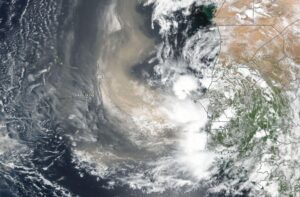
On Sept. 22, 2022, the CPEX campaign encountered and measured one of the largest dust events that NASA has ever sampled. While the DC-8 Airborne Laboratory captured data with its instruments, the Visible Infrared Imaging Radiometer Suite (VIIRS) affixed to the Suomi NPP spacecraft captured the event from space as pictured above. (Credit: NASA)
When the dust that wafts off the Sahel and Sahara regions of Africa mixes with tropical clouds, it creates what’s known as a rainy “disturbance” in the eastern Atlantic. These disturbances are hurricanes in their youngest form, and as they travel across the ocean, they can either dissipate or grow into powerful storms.
To study these infant storms, a group of NASA scientists in September 2022 spent a month flying off the northwestern coast of Africa aboard NASA’s DC-8 research plane. Each day, the team took off from Cabo Verde, an island nation off the west coast of Africa, logging roughly 100 hours altogether. The mission, known as the Convective Processes Experiment – Cabo Verde (CPEX-CV) released its data publicly on April 1, 2023.
The CPEX-CV team operated from September 1-30, 2022. Using state-of-the-art remote-sensing lidars, radars, radiometers and dropsondes—11-inch, lightweight tubes equipped with a parachute dropped from the plane to measure wind, temperature and humidity—scientists captured and logged data for each flight. This month, the instrument teams have submitted data to their respective NASA data archive centers, the NASA Atmospheric Science Data Center and the Global Hydrometeorology Resource Center.
Read more here.
